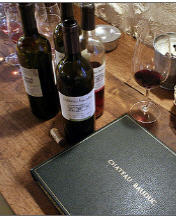 Greetings! Today, I have another terrific guest article to share with you. This time, author of 50 Asks in 50 Weeks and certified fundraising consultant Amy Eisenstein, (pictured at left) has been kind enough to share one of her recent blog posts with us.
Greetings! Today, I have another terrific guest article to share with you. This time, author of 50 Asks in 50 Weeks and certified fundraising consultant Amy Eisenstein, (pictured at left) has been kind enough to share one of her recent blog posts with us.
If you’ve never visited Amy’s site, TriPointFundraising, I highly suggest that you take a few minutes, when you’re done reading this piece, to click on over. She has a wealth of useful information for people actively engaged in raising money for non-profits.
I want to thank Amy for her generosity in sharing this very valuable information about grant writing with us. I hope you enjoy this post and get to know Amy better! ~ Jim Berigan
Raise More Money Selling Sponsorships, Not Tickets
“Should we lower the ticket price to our event?” is the question I have been asked over and over by clients and colleagues this year. My answer is an emphatic NO!
There are two primary reasons: First, there are people who have the ability to continue to pay the regular ticket price (or sponsorship level). By lowering ticket prices (and sponsorship levels,) you are leaving money on the table. Second, you are lowering expectations for subsequent years.
So, if some individuals and companies won’t be able to participate at their usual levels due to the economy, what do you do? Call them. Talk to them. Tell them how much you appreciate their past support of your event. Explain that you noticed that they had not renewed for this year, and ask if it was an oversight (just in case it was). If not, ask at what level they might be able to participate again this year. Welcome them back at any level, and offer to give them the benefits and perks of their normal, higher level, with the expectation that they will be able to come back at higher levels in future years. Do this with companies and individuals, for sponsorships and individual tickets.
My advice: Do not leave money on the table or lower expectations for your event. Do not lower ticket prices this year.
Why Have Events?
Events are the most time intensive and expensive type of fundraising, so why do we have them? Events are an opportunity to:
- Showcase your organization to your current supporters and members of the community,
- Make a lot of money from companies and people who might not otherwise give,
- Build your database, and
- Raise unrestricted, operating dollars, which are difficult to raise in other ways.
I believe every small development shop should have events, but only one annual one, or two at the most. (Planning more than two events per year will not leave time for other important components of fundraising, such as individual cultivation and solicitation, grant writing, bulk mail, etc.) Despite the drawbacks of events, if you have the staffing capacity to hold an event (or two,) it should be well worth the effort.
Event Committees are for Fundraising, Not for Planning
When planning your event, the first step is to form a committee of board and non-board members to serve as your event committee. Ideally, you should have lots of people on your committee with various positions, titles, and connection in the community. Let each committee member know up front that you expect them to buy or sell at least one table, as a condition of serving on the committee. Lay out additional expectations, like attending occasional meetings and sending invitations with personal notes to friends and colleagues.
An event committee is a fundraising committee, and should not be expected to (or expect to) plan the details of the event. The first time I ever ran a major event, I made the mistake of including the committee on decisions like table cloth colors and dinner menu selection. While you may have one committee member who wants to be involved with event details, (and you may need to let them, for political reasons,) this should not be the primary focus of the committee. The committee exists to help you fundraise!
Event committee members have four key responsibilities:
- Determining the type of event,
- Selecting honorees and speakers,
- Setting sponsorship levels, and
- Selling tickets and tables.
Always make important decisions, such as selecting honorees and sponsorship levels, as a committee, (with staff recommendations and input, of course). This will ensure committee member involvement and “buy-in.”
Setting the Stage to Fundraise: Putting Your Committee to Work
1. Determining the Type of Event
Once the event committee is formed, the first order of business is to select the type of event. Staff should have one or two suggestions in mind to help guide the conversation. You may want to start the conversation via email ahead of the first meeting, so committee members can have ideas when they arrive, and you can move forward quickly.
One of the most common events among non-profits is the awards dinner event. It works well, because it serves as a friend-raiser and fundraiser. There are many other popular events such as golf outings, and dinner dances or galas.
While there are a variety of types of events to choose from, focus on events that easily lend themselves to sponsorship opportunities. I believe that any fundraiser where you sell things one at a time, are bad fundraisers. For example, cookie sales (except for in the case of the girl scouts). Likewise, magazine sales, wrapping paper sales, bake sales, car washes, etc., are bad fundraising events for any small organization. (Schools are perhaps the exception to this rule, because they have huge labor pools – students – to do the selling). Sponsorships are key to successful fundraising events, and you should stay away from events where things are sold one at a time (be it a ticket, or a box of cookies).
2. Selecting Honorees
If you are having an awards dinner or gala, selecting the right honorees is a critical step, because honorees can buy and sell sponsorships for you. Make a list of companies, individuals, foundations, and groups that support your organization. Which would you like to honor, and have the ability, and have the ability to buy and sell sponsorships. Utilize your committee member’s contacts in the community to secure the best honorees possible.
Most organizations opt to have more than one honoree, to leverage as many sponsorships and tables as possible. My rule of thumb is no more than three to four honorees. If you have more than four, it dilutes the meaning of the honor, both on the invitation and at the event. Having too many honorees also creates a long and boring program.
Just a note: having a politician as an honoree is always a fine idea (assuming you’re having more than one honoree,) but s/he will rarely (almost never) generate any ticket sales or sponsorships.
3. Setting Sponsorship Levels
The key to a successful event is to sell sponsorships, not (only) tickets. I always have a ticket price for the few individuals who will want to buy them, but the main focus should be on selling tables or sponsorship packages. Event revenue is raised in a traditional fundraising pyramid (ten percent of the people give ninety percent of the gifts, and ninety percent of the people give ten percent of the gifts). So start where the money is and solicit sponsorships.
To finish reading this article, please click here.







 Like a fine wine, the idea of actually hosting a fundraiser needed to age for a bit. Initially, I had visions of hosting a gala event, replete with a full bar, servers, a band, table linens, and a little black dress.
Like a fine wine, the idea of actually hosting a fundraiser needed to age for a bit. Initially, I had visions of hosting a gala event, replete with a full bar, servers, a band, table linens, and a little black dress. About mid-way through (at least 6 or 7 bottles into the evening), I thanked everyone again for all of their support and encouragement throughout my journey thus far and the checkbooks opened. I ended up with a total in excess of $1500 for that one evening (not including the wine and food donations). I even received donations from people who weren’t able to make it to the wine-tasting, but were kind enough to give those who did a check or cash to give to me!!
About mid-way through (at least 6 or 7 bottles into the evening), I thanked everyone again for all of their support and encouragement throughout my journey thus far and the checkbooks opened. I ended up with a total in excess of $1500 for that one evening (not including the wine and food donations). I even received donations from people who weren’t able to make it to the wine-tasting, but were kind enough to give those who did a check or cash to give to me!!

